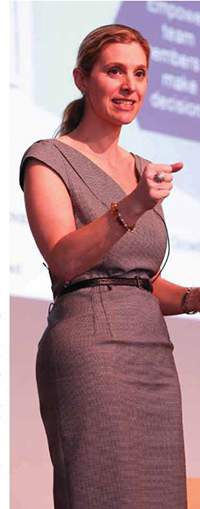the correlation between inclusion and innovation.
The power of difference
There has never been a more important time for the conversation about the links between innovation, inclusion and diversity.
Inclusion is probably the most important skillset of our time. Not only do we need inclusion to drive better business performance, but the reality is that most of the up-and-coming generation will not work in companies that don’t have inclusive cultures. We see it now with generation Y. They would rather move home with mom and live in the basement than go to work for Goldman Sachs. They believe that if they go to work for Uber, or Facebook, or Google, that they will be heard and they will have an opportunity to contribute in a way that they won’t at most companies.
Inclusion is probably the most important skillset of our time.
We need a set of leadership skills to unlock the power of difference. We’re calling it acquired diversity, which is the idea that certain types of life experiences have enormous value because they lead you to being a different kind of leader – to being inclusive, to help manage risk in more open ways, to actually welcome and look for feedback.
I’m not advocating that the answer to all of our problems is that we have to replace x with y. I’m not saying we have to push companies to replace their white male executives with women and diverse candidates. What I am saying is that in order for us to get the benefit and the full potential for innovation in our organizations, we need both. We do need diversity in leadership and decision making roles, but we also need leaders, no matter who they are or what they look like, who actually appreciate and know how to leverage and engage the power of difference.
Diversity of thought and acquired diversity
In some organizations the discussion around diversity of thought winds up obscuring some of the real value of acquired diversity. You don’t get the innovation payoff just from having a bunch of different people from different business units. You could certainly argue that if you have somebody from IT and somebody from marketing, you have diversity of thought and different experiences. But the thing that really is the differential is not just about how you think, but how you behave, how you lead, and how you interact with others.

“It is not an even playing field for ideas”
Is it enough for all of us to go to work and stick a bunch of women and people of color in chairs? Do we automatically get a better outcome in the marketplace by doing that? I suspect maybe not. For any of us who have been the ‘only’ in a room, just being in a chair doesn’t mean that your insights are heard, appreciated and make a difference.
It turns out that it is not a level playing field for ideas. In the competition for great ideas and innovation, it turns out that a huge percentage of innovation and business ideas and market growth strategies get left on the cutting room floor every day. Not because of the value or the quality of those business insights, but because of who had them.
A huge part of our capability for innovation is sitting inside our businesses already and we’re ignoring it.
Diversity at the IMF: A case study
In 2008 the IMF, which is of course tasked with mitigating global financial risk, put out a really extraordinary paper essentially denying that there was any threat to the global economy of a massive disruption. They put out this paper about three weeks before the collapse of Lehman Brothers. They were so chastened as an organization by this embarrassing lack of judgment and lack of ability to see something that many people did see coming, that they undertook an internal review.
Within the IMF there were economists from emerging markets, more junior in the organization, who were essentially jumping up and down and saying something terrible is about to happen. At the managing directorship of the IMF, it turns out that they could not see it. One of the major culprits of this systemic blindness was in fact that all of the managing directors at the IMF were white men. But more importantly, they had all gone to a collective three business schools. They had all been working together for more than 20 years. They were all from mature economies. They were incapable of hearing, even with compelling data, the arguments coming from within their own organization. When Christine Lagarde took over the IMF she really set to work looking at how they could transform not just the representative diversity in terms of the leadership ranks of the managing directors, but also what they needed to do culturally to create the kind of environment where dissent could be heard.
Receive AESC's Executive Talent Monthly - Insights for the C-Suite
